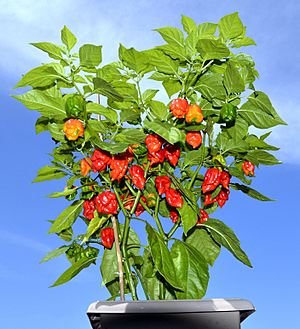Hottest chili pepper facts for kids
Especially among growers in the US, the UK, and Australia, there has been a competition since the 1990s to grow the hottest chili pepper. Chili pepper species and cultivars registering over 1,000,000 Scoville Heat units (SHU) are called "super-hots". Past Guinness World Record holders (in increasing order of hotness) include the ghost pepper, Infinity chili, Trinidad Moruga scorpion, Naga Viper pepper, and Trinidad Scorpion Butch T. The current record holder, declared in 2017, is the Carolina Reaper, at more than 1.6 million SHU.
Contents
History
Before the early 1990s, there were only two peppers which had been measured above 350,000 SHU, the Scotch bonnet and the habanero. California farmer Frank Garcia used a sport of a habanero to develop a new cultivar, the Red Savina, which was measured at 570,000 in 1994. At the time, this was considered to represent an upper limit of chili pepper hotness.
In 2001, Paul Bosland, a researcher at the Chile Pepper Institute at New Mexico State University, visited India to collect specimens of ghost pepper, also called the Bhut Jolokia or Naga king chili, traditionally grown near Assam, India, which was being studied by the Indian army for weaponization. When Bosland grew and tested the pepper, he discovered it measured over 1 million SHU. According to Bosland, this "kind of opened the floodgates". In 2006, the Dorset Naga (a subspecies of the Naga Morich) was claimed to be the hottest. In 2012, the Chili Pepper Institute called the Trinidad Moruga scorpion the new hottest pepper, saying it had been measured at 2 million SHU, the first time the 2-million mark had been reached.
Many of the cultivars developed in the attempt to produce ever-hotter peppers are hybrids of chilies traditionally grown in India and Trinidad.
Super-hots
The new peppers have been termed "super-hots". Super-hots are classified as peppers registering over 1 million SHU.
In 2015, Bosland and his team, using fluorescence microscopy, found that while most peppers store capsaicin primarily in their pith, super-hot varieties tend to store as much in their flesh as they do in their pith. While for most peppers removing the pith and seeds also removes much of the heat, for super-hots this is not true. Super-hots not only have more capsaicin than other peppers, but also store their capsaicin differently. In their report, Bosland et al call it a "novel discovery that these 'super-hot' chili peppers have developed accessorial vesicles on the pericarp tissue in addition to the vesicles on the placental tissue, thus leading to exceedingly high Scoville heat units for these plants."
The theoretical upper limit of super-hots is 16 million SHU, the level of pure capsaicin, but super-hots are likely to top out lower than this, as in any possible fruit, the capsaicin would be diluted by other plant tissues. In 2016, Bosland hypothesized a 3 or 4 million SHU pepper. Super-hots should be handled with gloves and using eye protection, as contact with even a single seed can cause skin irritation via chili burn.
Competition and certification
Chili growers compete with one another "ruthlessly" to create the world's hottest pepper.
The "crowning achievement" is being listed in Guinness World Records.
Impact
According to Bosland, the records are "mainly of interest as publicity for purveyors of sauces". As of 2013, hot sauce production and sales were among the fastest growing industries in the US, worth an estimated US$1 billion, and producers "sell more sauce with a world-famous chile on the label". Being able to claim the record can "make or break a new product". The developer of the Naga Viper pepper, which claimed the record for a short period in 2011, earned US$40,000 in one month from sales of seeds and sauces. The developer of the Trinidad Moruga scorpion, which claimed the record in 2012, made US$10,000 in two days selling seeds.
Seed sales are also an important revenue stream for developers. As of 2013, super-hot seeds were unavailable from commercial seed suppliers, so those wishing to grow the peppers could obtain them only from the developers or small specialty suppliers. According to Dave DeWitt, in 2013 "a typical Scorpion pepper pod at a farmers’ market [would] go for one dollar". A bottle of hot sauce claimed to have 16 million SHU sold for US$595. Chiliheads make YouTube videos showing themselves eating super-hots as a means of providing entertainment or marketing the heat of a particular pepper.
In Nagaland, India, the annual Hornbill Festival includes a ghost pepper-eating competition.
Hottest peppers
Record holders
Between 2007 and 2012, Guinness "fielded 25 different claims to world's hottest". As of 2019, Guinness lists the Carolina Reaper as the hottest pepper.
| Cultivar | Image | Capsicum species | Developer | Country | Scoville units | Guinness |
|---|---|---|---|---|---|---|
| Carolina Reaper |  |
C. chinense | Ed Currie | US | 1,641,183 | 2017 |
| Trinidad Scorpion Butch T | 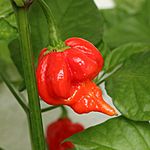 |
C. chinense | Butch Taylor Marcel de Wit |
US Australia |
1,463,700 | 2011 |
| Naga Viper |  |
C. chinense × C. frutescens | Gerald Fowler | UK | 1,382,000 | 2011 |
| Trinidad Moruga scorpion | 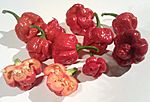 |
C. chinense | landrace | Trinidad | 1,200,000 | 2012 |
| Infinity | C. chinense | Nick Woods | UK | 1,176,182 | 2011 | |
| Ghost pepper | 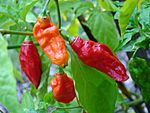 |
C. chinense × C. frutescens | landrace | India | 1,001,000 | 2007 |
| Red Savina | 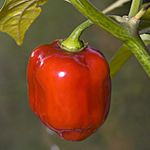 |
C. chinense | Frank Garcia | US | 570,000 | 1994 |
Contenders
| Cultivar | Image | Capsicum species | Developer | Country | Alleged SHU | Introduced |
|---|---|---|---|---|---|---|
| Pepper X | C. chinense | Ed Currie | US | 3,180,000 | 2017 | |
| Dragon's Breath | C. chinense | Neal Price | UK | 3,000,000 | 2017 | |
| Chocolate 7-pot | C. chinense | landrace | Trinidad | 1,800,000 | ||
| Komodo Dragon | 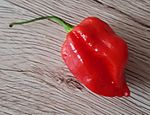 |
C. chinense | landrace | UK | 1,400,000 | 2015 |
| Armageddon | C. chinense × C. frutescens | landrace | UK | 1,300,000 | 2019 | |
| Dorset Naga (subspecies of Naga Morich) |
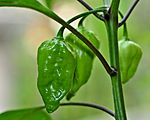 |
C. chinense | Joy and Michael Michaud | UK | 1,201,000 | |
| Naga Morich |  |
C. chinense | landrace | India and Bangladesh | 1,000,000 |


